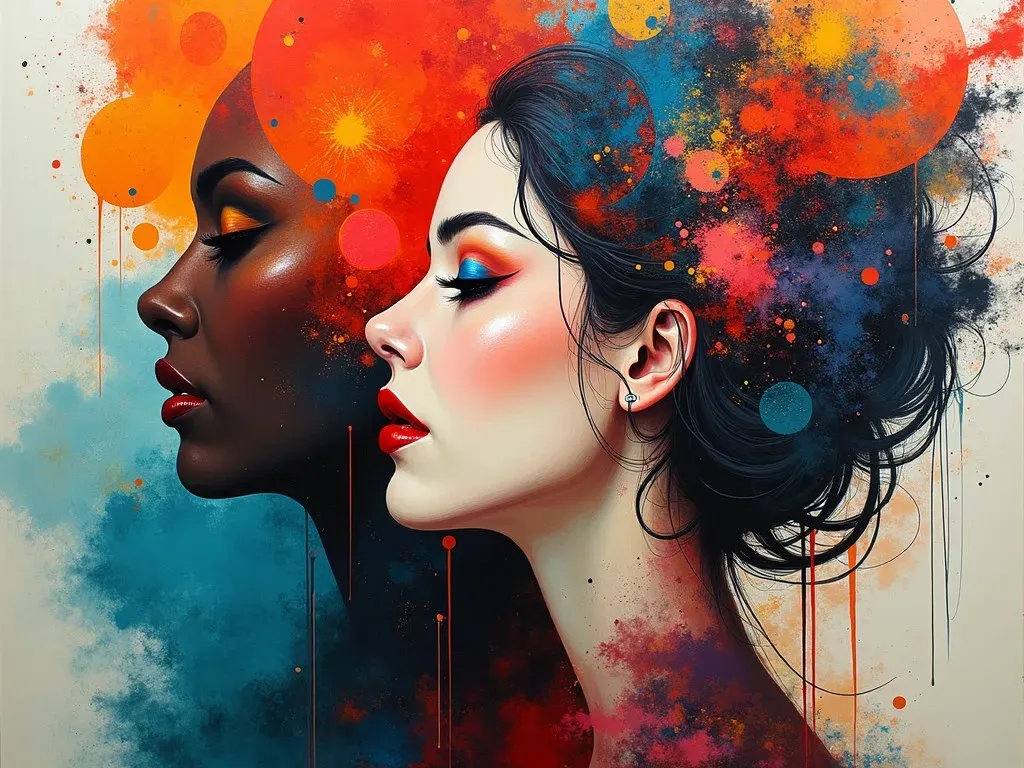Abstract paintings of women offer a remarkable glimpse into the vast exploration of femininity, identity, and emotion in contemporary art. These captivating works often defy traditional representation, inviting viewers to engage with the canvas on a deeper, more personal level. The abstract female form, with its vibrant colors and fluid shapes, allows for an exploration of themes that resonate with the very essence of womanhood.
The Impact of Abstract Art
Abstract art, particularly when focused on women, acts as a powerful medium for self-expression. It distills complex emotions and ideas into visual form, creating a unique dialogue between the artist and the audience. The abstract representations are less about depicting physical reality and more about evoking feelings and evoking personal interpretations.
Importance of Women in Abstract Art History
Historically, the contributions of women in this genre have often been overshadowed by their male counterparts. However, female artists have been at the forefront of abstraction, breaking boundaries and redefining spaces.
- Women in Abstract Expressionism: Key figures include Joan Mitchell, Helen Frankenthaler, and Lee Krasner, who navigated and influenced styles that became iconic.
- Contemporary Art Scene: Today, a new generation of women artists is reshaping abstract painting by addressing contemporary themes through their unique lenses.
Notable Abstract Female Artists
| Artist | Contribution | Notable Work |
|---|---|---|
| Joan Mitchell | Known for her dynamic brushwork; her works captivate with energy and emotionality. | "City Landscape" |
| Helen Frankenthaler | Pioneer of color field painting; she used a soak-stain technique that transformed abstraction. | "Mountains and Sea" |
| Lee Krasner | Integral in the Abstract Expressionism movement; her works are characterized by bold forms and vibrant colors. | "Gaea" |
| Rachel Jones | Contemporary artist known for her use of vivid colors to explore identity and belonging. | "Feminine Power" |
| Tala Worrell | Uses layers and textures to engage with themes of culture and emotion in her works. | "Material Memories" |
Exploring Themes in Abstract Paintings of Women
-
Identity and Femininity:
- Abstract paintings of women often navigate the complex narratives surrounding their identity, challenging and redefining traditional notions of femininity. Artists like Rachel Jones explore cultural backgrounds and intersectionality through vibrant forms.
-
Emotion and Spirituality:
- Abstract representations can serve as cathartic expressions of emotion. The swirling colors and dynamic forms invite viewers into the spiritual and emotional journeys of the artists.
-
Socio-Political Commentary:
- Many contemporary female abstract artists address significant socio-political issues through their work. Their art often reflects experiences of marginalization, resilience, and empowerment.
The Evolution of Abstract Female Paintings
Historical Context
Historically, abstract art has been predominantly male-dominated. Yet, women artists have consistently introduced innovative methods:
-
Early 20th Century: Foundational works by artists such as Wassily Kandinsky and Piet Mondrian began to shape what abstract art would become. However, the followers and contributors behind the scenes, many of whom were women, cultivated the movement further.
-
Post-War Era: The emergence of Abstract Expressionism saw women artists like Krasner and Mitchell actively creating and exhibiting their works, pushing the boundaries of the genre.
Contemporary Scene
Today, we witness a flourishing of female abstract artists from diverse backgrounds:
-
Emerging Artists:
- A new wave of artists is redefining abstract painting with unique cultural identities and experiences. Their works often resonate with themes of contemporary life, identity, and emotional expression.
-
Global Influence:
- The globalization of the art world has allowed for the emergence of a variety of styles and influences. Women artists globally are now gaining visibility and recognition for their contributions to abstract art.
Frequently Asked Questions (FAQ)
Q1: What are abstract paintings of women?
A1: Abstract paintings of women refer to artworks that represent female forms or themes through non-representational abstraction, focusing on colors, shapes, and emotional expressions rather than realistic depictions.
Q2: Who are notable women abstract artists?
A2: Some notable women in abstract art include Joan Mitchell, Helen Frankenthaler, Lee Krasner, and contemporary artists like Rachel Jones and Tala Worrell.
Q3: How does abstract art empower women?
A3: Abstract art allows women to tell their stories, express their emotions, and challenge societal norms, thereby empowering their narratives and experiences in a visual medium.
Q4: Where can I find abstract paintings of women?
A4: Online art platforms like Fine Art America offer a wide range of abstract paintings of women for sale.
Q5: What themes are commonly explored in abstract art by women?
A5: Common themes include identity, emotion, spirituality, and socio-political commentary, often reflecting personal and collective experiences.
The Future of Abstract Paintings of Women
The realm of abstract paintings of women is continuously evolving. As new voices rise and fresh perspectives emerge, these artworks will keep pushing boundaries and inviting audiences to engage with deeper themes.
By honoring the past and embracing the innovations of the present, we can anticipate a future where women’s contributions to abstract art are celebrated and recognized globally. Their vibrant emotions and rich narratives will continue to captivate and inspire generations to come.
